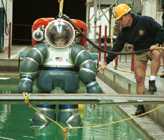|







EMFN (DV) Nathen Kibbler of Kleene, Texas, is one of only four
technicians attached to Deep Submergence Unit's
Hard Suit
2000.
Photo by PH2 Aaron Ansarov

EMFN(DV) Nathen Kibbler practices his manuevers in
the Deep
Submergence
Unit's pool at San Diego. These men must train extensively
and log numerous hours in the suit before they are qualified to make dives
in the open ocean.
Photo by PH2 Aaron Ansarov

Inside a suit that has an almost space-like appearance, EMFN (DV)
Nathen Kibbler of Kleene, Texas, begins a long day in the suit, conducting
endurance tests. Each man must stay inside the suit for long hours in
order to calculate the limits a diver can withstand.
Photo by PH2 Aaron
Ansarov
|
Experimental Dive Suit Flies Navy Divers Where None Have Gone
Before
The Ocean ... the final frontier ... These are the voyages of the
men attached to Hard Suit 2000. Their ongoing mission: to seek out
distressed submarines, to give fast recovery to them and anything else
that the Navy may need and to boldly go where no diver has gone
before...
 Sounds like something from the
Sci-Fi Channel, right? Not quite: This is real life and it's happening to
nine Sailors in San Diego. The small cadre, who can call themselves
explorers of the deep, were recently picked to test and operate a
revolutionary suit capable of almost any mission at great depths: the Hard
Suit 2000. Sounds like something from the
Sci-Fi Channel, right? Not quite: This is real life and it's happening to
nine Sailors in San Diego. The small cadre, who can call themselves
explorers of the deep, were recently picked to test and operate a
revolutionary suit capable of almost any mission at great depths: the Hard
Suit 2000.
The special dive
suit, loaned to the Navy for testing from a Canadian company, has an eerie
resemblance to the Michelin Man and is clunky and unsophisticated. But
when a Sailor climbs inside the special suit, it comes alive.
The "2000" in Hard
Suit 2000 doesn't come merely from the year 2000. Two triple zero refers
to the extreme depth at which the Hard Suit can operate: 2,000 feet below
the surface of the ocean, which is the deepest any diver has gone without
making a saturated dive.
"In a saturated dive,
the body is pressurized and saturated with nitrogen," said Signalman 2nd
Class (DV) Timothy Roff, a Navy diver attached with Advanced Diving Suit,
the North Island-based Deep Submergence Unit (DSU). "In the past, a diver
could spend a week at depths like this, but they would have to spend
another two weeks in a decompression chamber to recover. The Hard Suit
makes all that a thing of the past."
Before the special
suit was developed, divers spent days to descend to 2,000 feet. "With the
Hard Suit 2,000, we can get to 2,000 feet in 20 minutes," said Roff. "We
can spend almost eight hours down there, bring the suit back up, and
change out men without any decompression or loss of manpower."
Roff said they could
have a man switched out and back at 2,000 feet in under an hour, while the
person relieved can rest for the next shift.
For the lucky nine at
the DSU, working with the multi-million dollar specialized suit has been
an opportunity long in coming. Months before they got the suit, the Navy's
great dive reputation reached a company in Canada - the manufacturers and
designers of the suit - and they struck a special deal. The Navy agreed to
conduct extensive testing, not just in putting guys behind the controls or
even in the maintenance, but to help in setting the standards. Everything
these nine men do with the suit will be logged and used as the standard
for years to come. From writing the maintenance cards to setting the limit
for stay-time in the suit, these diving pioneers - enlisted men in the
Navy, will chart it all.
"I feel extremely
lucky," said Engineman (DV) Nathan Kibbler. "As a technician, I've been
responsible and proficient in knowing every wire, bolt, knob and gear of
this suit." The Texas native is one of only four technicians in the world
to be trained to maintain the suit. "Kibbler can actually take the suit
apart into hundreds of pieces and put it back together single-handedly,"
said Roff. "He's also probably the only fireman in the Navy who is writing
maintenance cards."
Being a part of
anything big is said to have its sacrifices, and the team members of DSU
feel the same. Long hours with multitudes of repetitious checks, rechecks
and cleanings before this suit can even touch the open ocean are some of
those sacrifices. They have to be. There are, after all, lives at stake.
The mission of this suit is endless. "It can be used to assist in the
recovery of distressed submarines, salvage missions like January's Alaska
Airlines crash and a wide variety of things that we haven't even thought
of yet," said Roff.
Pitted against an
unmanned Robot Operated Vehicle (ROV) - the Navy's current technology -
the Hard Suit wins hands down. "We can see in three-dimension as opposed
to a two-dimensional screen for one," said Roff. "We can also see 180
degrees and can reach into tighter places. It's just a lot more
descriptive as to what we can see down there."
The most interesting
part of the suit may not be the aluminum joints (each of which are
specially cut from large blocks of super high-grade alloy) or even the
fact that each of them are held together by a simple plastic wire slightly
bigger than fishing line. What most of these divers agree on is the fact
of safety. "Everything in this suit is safe," said Roff. "We really feel
safe. And when we feel safe, especially at 2,000 feet, we can do our job
much better."
There are many
factors that interfere with working properly in extreme depths, like cold
temperatures, total darkness and not knowing what is on the ocean floor.
"With the Hard Suit, we don't walk or swim: we fly," said Boatswain's Mate
3rd Class (DV) Aaron M. Tomforde, one of the technicians with the crew.
"With large propellers on the side controlled by our feet, we fly to our
destination in almost any situation. Of course, it takes lots of
practice."
Practice is what
these men have been working on. Using a large indoor pool in their giant
hangar, these men train extensively to find the extremes at which the suit
can safely operate. "We have to find the levels to which we can set
standards for divers in the future," said Machinery Repairman 1st Class
(DV) Kent Kruse, who set a record for the suit, operating it without
external power for almost nine hours.
By the end of the
year, the men stationed with the Hard Suit 2000 will be fully operational
and able to handle anything that is thrown their way. From recovery of
crashes to recovery of downed submarines. Any way it's used, this suit
will surpass any technology in use today.
At any given time,
you can hear Navy divers saying, "Our pride runs deep."
These nine Sailors
are going to ensure it runs deeper.
Story
and photos by PH2 Aaron Ansarov, a photojournalist for All Hands San Diego
Det. |